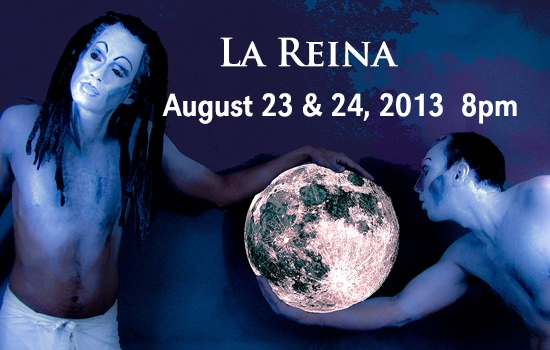La Reina doesn’t have a genre to contain it. The show features a collage of ancient texts and travels from Antiquity, the Golden, Classical and Dark Ages, to the Medieval and Reformation period. Using shadow puppetry, brightly-illuminated backdrops, stunning costumes, movement-theater and a live electronic soundscape, the production takes on a dream-like quality. It is as if a wild, somewhat surreal vision is playing out before the audience, and its tempo is slow and unhurried. The production, under the direction of Aaron Beck, debuted this weekend at Diana Wortham Theatre with two evening performances held on Friday and Saturday, Aug. 23 and 24.
La Reina, performed by a cast of nine actors, three women and six men, isn’t an easy production to digest. Though the show is extremely visual, and the set-design beautifully sculptural, the story and collage of text is very hard to follow, especially after act one.
The script and theme of the production focus on the role of women in ancient society: From revered goddesses to the duties of daughters and a wives. The production opens with actress Dahlia Legault, sitting in a thrown-like chair, reading a list of laws. The laws outline the proper code of conduct “should a man take a wife” and not bare him sons; or “should a man take a wife” and she fall ill. Legault’s voice is amplified and echos, adding intensity and power to this opening scene. The reading of these laws continues throughout the show, and becomes a thread that ties La Reina together, though loosely.
Act one is the most accessible, and because of that, it is the strongest piece of the production. Act one tells the story of the Goddess Inana, who abandons the Heavens and abandons the Earth in order to enter the Underworld. The role of ritual and prayer is portrayed as Inana, played by the striking Luke Arrington, dresses for her journey. She is given seven divine garments, including a turban, a lapis necklace and long, flowing robes. Inana asks her loyal subject, Nincumbura, played by Dylan Henley, to pray for her safe return.
At each of the seven gates of the Underworld, Inana is stripped of her divine garments. The Queen of the Underworld is portrayed as a dark and frightening shadow, whose silhouette is cast upon the white canvas of a massive frame. Her neck and arms are decorated with feathers, and her persona is fully imagined by costume designer Alexis Gault. In the holds of the dark queen, Inana is killed and her corpse hung on a hook.
In act two, the god Enki, played by Brit L. Castañeda, creates the character Galatura-Kujara, a two-faced jester. Galatura-Kujara, performed by the light-footed, talented Glenn Reed, makes his way through the Underworld and manages to save Inana using the “plant of life” and “water of life.” Inana, however, can not leave unscathed, and she must forfeit the life of another to take her place in the Underworld.
In act two, the story of Inana shifts, and the text focuses on other monologues including Tamburlaine the Great by Christopher Marlowe, Coriolanus by William Shakespeare and Ordo Virtutum by Hildegard of Bingen, among others. Many of these readings are delivered in chorus, with three actors, Steve Lansford, Valeria Watson-Doost and Castañeda, speaking together in slow monotone. The chorus-style delivery can feel very monotonous, and the pace of the production, especially in act two and three, begins to crawl. The over two-and-a-half hour production challenges audiences in many ways, and the length of the show does take away from its potential.
The ancient texts woven into La Reina, paired with vivid lighting, live music and baroque garb, creates a surreal atmosphere. Like a dream, one feels as if they are fading in and out of a colorful scene. There are vivid moments, while others are obscure and out of reach. La Reina, often disorienting, but always visually striking, invites its audience to occupy a time and space of its own.




I would like to note that the actor reading the Code of Hammurabi in Act I and throughout the production was actually Dahlia Legault, who has also taken lead roles in Crave, produced by Anam Cara Theatre Company this past April, and Romeo Loves Juliet, produced by Different Strokes Asheville last November.
This is a useful, and well written review. I appreciate that the reviewer focused on positive as well as negative aspects of the show. As theater artists, especially ones who hope to grow and produce at an increasingly professional level, we need this kind of review to both acknowledge what worked, and point out what needs to be improved. Please continue to publish reviews like this.
Thanks for the correction, amvaneepoel! Much appreciation.